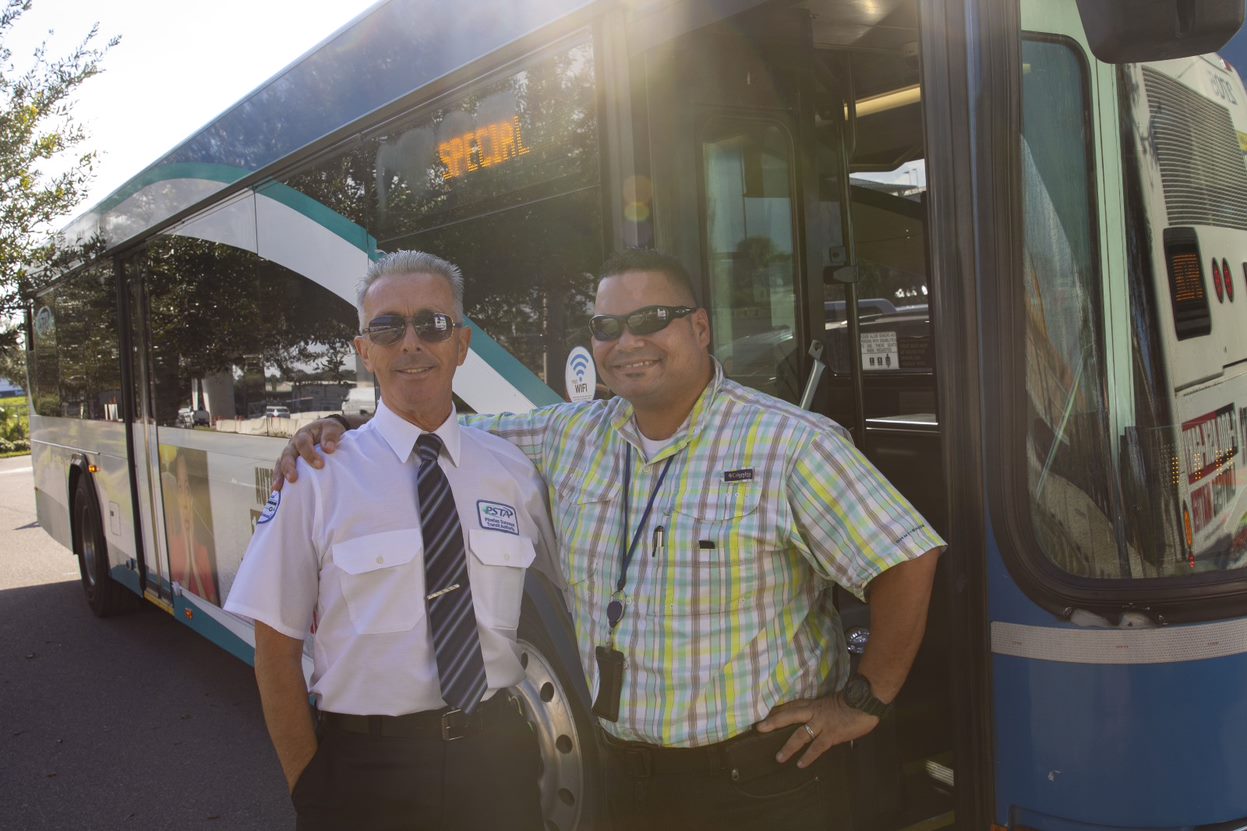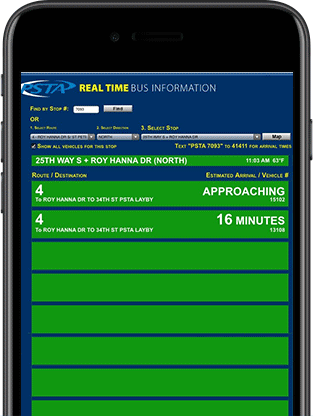
Ever wonder what it takes to become a PSTA bus operator or technician? Repairing or driving these incredible 40-foot vehicles while maintaining the safety of coworkers and riders is no easy task. Thankfully, PSTA offers comprehensive training programs for these essential positions, and more training is soon to come as we await the highly anticipated arrival of our new electric buses.
Why Do Technicians and Operators Need Training?
For technicians and bus operators, everything begins with safety. Technicians need to understand how buses work, from the engines to the batteries on hybrid and electric buses. One wrong move and the technician can put themselves and others in danger, so training is essential to avoiding workplace accidents.
In the case of bus operators, the need for safety is obvious—a bus full of riders and a road full of drivers are counting on the operator to drive the vehicle safely and responsibly. Operators not only need to learn how to properly operate the bus, but also how to keep the riders onboard safe and navigate challenging traffic situations.
So with the “why” out of the way, let’s dive into the nitty gritty of how technicians and operators are trained and how PSTA is committed to ensuring continued safety even after training has ended!
How Technicians are Trained
To start with, all technicians are required to have at least one year of experience working on cars and will begin at the position of “Fleet Technician I.” In order to receive a promotion to “Fleet Technician II,” technicians must complete the PSTA Vehicle Maintenance Training Program, an in-depth program that comprises eight modules, each including instructor lead sessions and hands-on tasks and assessments.
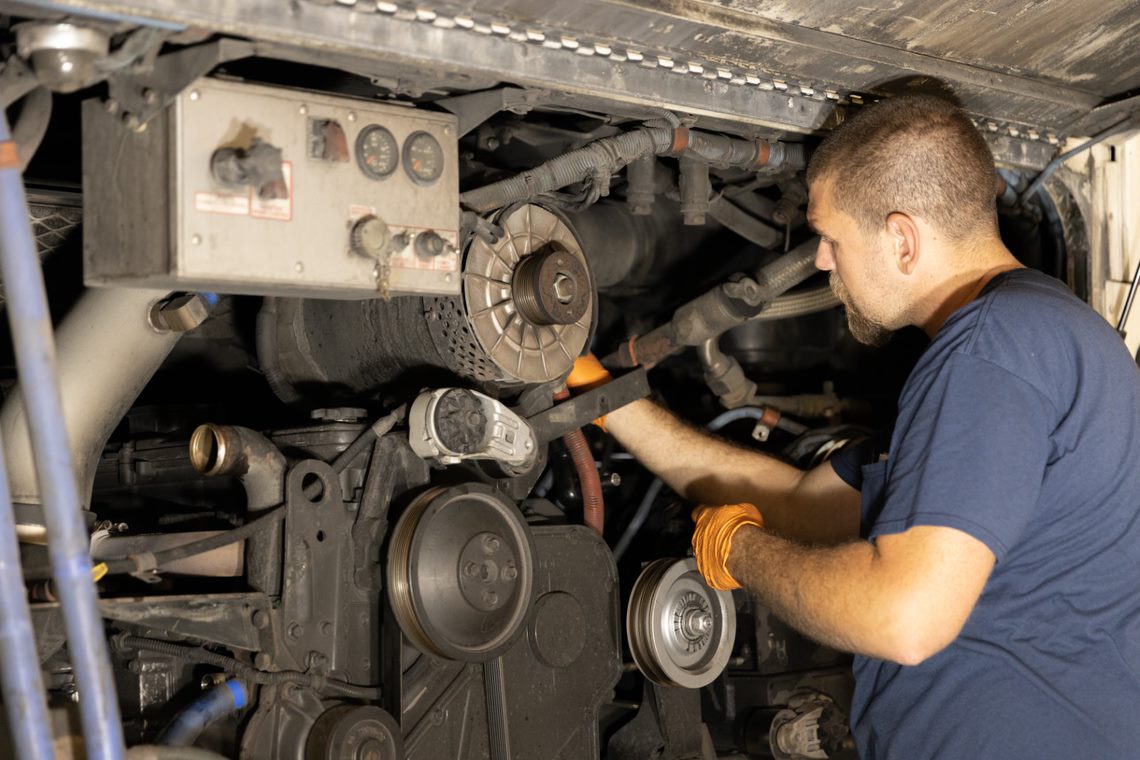
Throughout the training program, students are given a pretest, classroom instruction, learning tasks and course work, and end with a post-test to measure how much knowledge they’ve gained. Each module follows a 3-day schedule and is led by an instructor. Classroom instruction is followed up with the students performing tasks related to the module for on-the-job training (OJT). Depending on the module, bus parts are provided for the student to familiarize themselves with and physically work on.
The PSTA Vehicle Maintenance Training Program usually takes three years to complete, and each student must document the hours they spend on each module to ensure they fully learn the material. Once completed, the technician is promoted to “Fleet Technician II.”
In order to achieve “Fleet Technician III,” technicians must undergo ASE Transit Bus Technician Certification certification. Obtaining ASE (Automotive Service Excellence) ASE Transit Bus Technician certification is no easy task, however. In order to receive ASE certification, technicians must pass the ASE Certification Exam for these topics:
- H2 Diesel Engines
- H3 Drive Train
- H4 Brakes
- H5 Suspension & Steering
- H6 Electrical / Electronic Systems
- H7 Heating, Ventilation & Air Conditioning (HVAC)
- H8 Preventive Maintenance & Inspections (PMI)
And they must have two years of on-the-job training or one year of on-the-job training and a two-year degree in automotive repair to qualify for certification.
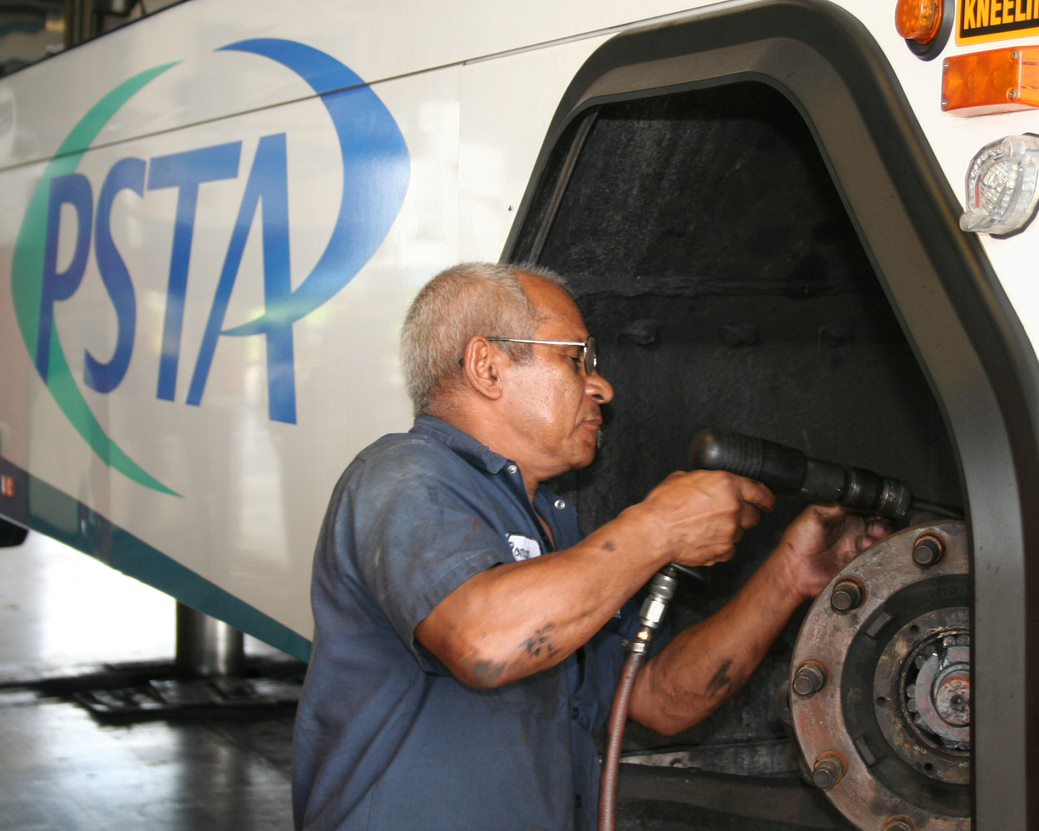
So, what sorts of things must technicians learn to safely maintain buses?
- Foundation and safety of bus maintenance
- Basic tools and lubricants used
- Preventative maintenance and inspections
- Suspension and steering
- Commercial vehicle tires, wheels, hubs, and rims
- Air braking system, anti-lock brake, vehicle stability, and collision avoidance systems
- The basics of hydraulic circuits, fluids, filters, and reservoirs
- Automatic transmissions, drive shafts, heavy truck axles, and hybrid drive systems
- Electrical systems, circuit protection, battery technology, charging systems, lighting systems, and on-board instruments
- Bus heating, ventilation, and air conditioning
- Bus diesel engine foundations and safety
How Bus Operators are Trained
Let’s switch gears now and go over operator training. The biggest step for new operators to legally have a career driving buses is obtaining their CDL or commercial driver’s license. Although some applicants may already have their CDL and experience driving buses, not all do, as PSTA does not require a CDL to apply for the position.
Lucky for future bus operators, PSTA is actually an approved CDL tester for the state of Florida—this means new drivers can get trained and tested all on-site, which saves them money and time! Operators first begin with ten weeks of training and, once training is complete, operators will then take their CDL. If they pass, they begin their career as a bus operator!

Let’s go over the bus operator training timeline in more detail:
- Week 1 and 2: the basics and theoretical bus knowledge, policies, and Transportation Safety Institute (TSI) training, which is a two or three-day process.
- Week 3: learning bus displays in the cockpit area and very basic driving in a controlled environment in the lot.
- Week 4, 5, and 6: CDL prep and continued driving training.
- Week 6 and 7: CDL test is scheduled with the state and continued driving training
- Last two weeks: on-the-job training with veteran PSTA operators to learn the routes, fare boxes, securing wheelchairs, etc.
By the time training is complete, trainees will have 60 to 80 hours of driving under their belt. Many of these hours will occur at night, both for the advantage of clearer roads to practice on and to learn how different Pinellas County can look at night.
While anyone ready to learn is welcome to apply and jump into training, PSTA offers an Early Starters program that has seen great success. Early Starters allows applicants the opportunity to come to class a few weeks before training starts and ride the buses. As they ride, applicants can see what the operator experiences on a day-to-day basis and understand the reality of the job. Early Starters also helps applicants begin building a rapport with other applicants and drivers, so by the time they begin training, they already have some friends at PSTA.
Training for Electric Buses
As PSTA makes the transition to a fully electric fleet, training will be essential for all technicians and operators to ensure we maintain the utmost safety we expect from diesel and hybrid operation and maintenance. In fact, much of the current training for both positions focuses heavily on the operation and maintenance of diesel and hybrid buses—all-electric buses are a whole different animal, however.
Although we discussed some of these changes in our last Deep Drive “All About Electric Buses,” let’s talk about how training for technicians and operators will change as we herald the arrival of our electric fleet!
Technicians
For technicians, electric buses couldn’t be more different. To start with the most obvious, electric buses have no engine! Instead, they are completely powered by 686 kWh lithium-ion batteries that not only propel the vehicle but also power the A/C & heating, power steering, and other onboard accessories.
The biggest safety risk technicians face with electric buses is the risk of exposure to fatally-high voltages. Understanding what components wield dangerous voltage and how to make them safe enough to work on can be literally life or death. That’s why many technicians will be required to take the NFA 70P, a 5-hour class and certification that teaches technicians all about electrical safety in the workplace for qualified persons.
The NFA 70P goes over the basics of electrical safety, how to determine electrically safe conditions, how to identify shock and arc hazards, and what equipment you should work with. In layman’s terms, the class teaches technicians how to make an area safe and avoid accidental death from high voltage.
On top of this electrical certification, technicians will undergo training from the electric bus manufacturer, GILLIG. In truth, learning to safely maintenance our electric fleet will be a massive undertaking and there will no doubt be a few hiccups along the way. However, PSTA is fully committed to weathering these changes for the future of our planet.
Operators
As mentioned in our electric bus blog, driving an electric bus is very different than a diesel or hybrid bus. Everything from the displays and steering wheel to the braking and acceleration is different on electric buses. Operators will need to undergo additional theoretical and hands-on training to learn and become comfortable with these new changes.
Some major changes will include fully digital displays, smaller steering wheels, a different turning radius, and changes in response to braking and acceleration. While these differences may seem small, they can have dangerous consequences if not fully understood. For example, pressing the accelerator in an electric bus will result in instant propulsion, unlike the small delay operators are used to with combustion engine buses.
Aside from understanding the basic differences in operation, training will be essential to help operators learn how to maximize the range of our new electric buses. For example, operators will have to learn to let the bus coast instead of constantly hitting the brake. Why? Because the bus coasting to a slower speed can actually recharge the battery!
The Future of Training and Safety at PSTA
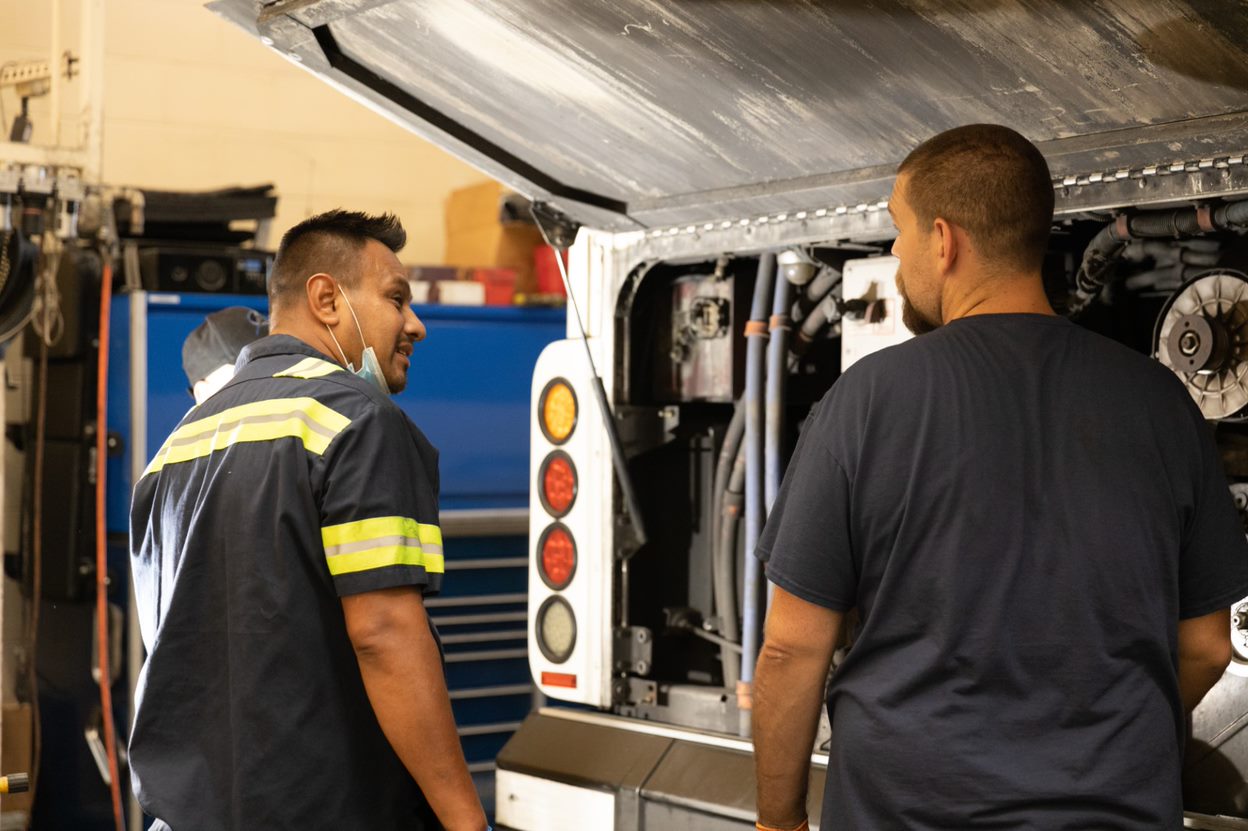
As PSTA’s fleet grows in this new sustainable direction, training will have to evolve—and not just for technicians and operators. In many ways, a fully electric fleet is uncharted waters and will require the dedication, ingenuity, and creativity of everyone to meet ever-changing needs.
Truthfully, the transition to electric may leave behind or divide technicians and operators who are more comfortable with traditional, combustion-engine vehicles. However, PSTA is excited to meet that challenge and is dedicated to improving training that keeps those talented technicians and operators up-to-date, engaged, and excited to learn new systems that will define the future of green transportation!
